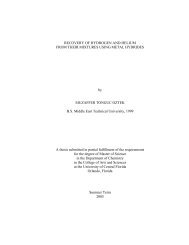Create successful ePaper yourself
Turn your PDF publications into a flip-book with our unique Google optimized e-Paper software.
1. INTRODUCTION<br />
The focus of this study is the separation of hydrogen helium mixtures formed at<br />
the Kennedy Space Center (KSC), where hydrogen is used as fuel for the space shuttle<br />
main engines, as well as in the fuel cells, and helium is used as the purge gas. The waste<br />
purge gas is one of the two different kinds of hydrogen loss at the center. The other is the<br />
loss of hydrogen from boil off from the liquid.<br />
A major loss of hydrogen from boil off occurs when liquid hydrogen brought by<br />
trucks and rail cars is transferred to storage dewars via insulated pipelines and from<br />
storage to the necessary units such as fuel tanks. In this process, loss of hydrogen occurs<br />
through<br />
• Cooldown of the vacuum-jacketed lines<br />
• Flash evaporation as high pressure liquid enters the low pressure dewar<br />
• Cooling of the inner skin of the dewar with the rising liquid<br />
• Displacement of the gas above the liquid in the ullage space.<br />
The waste gas is vented to the atmosphere or burned. This boiled off gas is pure hydrogen<br />
and its recovery has been studied previously[1].<br />
The flash evaporation of hydrogen as pressure decreases from a tanker transfer<br />
pressure of approximately 0.26 MPa (2.57 atm) to a dewar storage pressure of 0.12 MPa<br />
(1.18 atm) is the step in the hydrogen transfer that incurs the greatest amount of loss. It is<br />
also identified as the most cost effective and readily recoverable loss [2]. It was estimated<br />
that 1.5 million gallons (5.68 x 10 3 m 3 ) of liquid hydrogen can be recovered. A total of<br />
1



